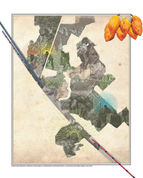
Citizen 9231772 Migration Review
Project City
Abidjan, Cote d'Ivoire
Student Name
Ian Dillon
Narrative Text
In 2032, Cote d’Ivoire invested heavily in sustainable agricultural practices across the country, reversing the trend of deforestation and restoring agricultural production to its mid-century high.
Shortly after, Abidjan recaptured its regional and international role as the exchange point of West African goods and culture. This economic revitalization sparked huge infrastructural expansions in each of the city’s communes, as well as construction of three new communes to accommodate increasing flows of migrants into the Abidjan. The expansion of the agricultural industry led the city to develop a new market to sell agricultural products and provide a place of cultural exchange for the variety of traditional cultures across the region. The Abidjan Market of Culture is located at the tip of the Plateau, overlooking the Ebrie Lagoon and the Vridi Canal. Furthermore, Abidjan repurposed its damaged port infrastructure, creating the point of entry for new intercontinental migrants.
Upon the formation of the Pan-African Union, Abidjan became an immigration center for West Africa and the continent. Migrants poured into the city from the surrounding regions and internationally at the Pan-African Immigration AI’s (PAIA) discretion. PAIA sorts and directs the flow of new peoples using biographical, linguistic, and other factors to place new citizens in the city best suited for them on the African continent. New migrants to the continent are required to stay within their assigned city for 5 years. As per the Pan-African Union Government Compact (PAUGC), all citizens and new immigrants must be tagged with a chip, allowing the AI system to monitor all citizens movement and activity. Monitoring gates were established throughout all major cities to register citizen movement and ensure proper immigration practices. PAIA officials believed that the constant presence of the AI will help new migrants to keep the immigration laws in mind.
To help facilitate the expansion of the cultural development of new citizens, Abidjan developed the Ligue Interculturelle, an institution that focuses on the diversity of cultures that make up the Ivorian identity. In response to the potential homogenization of the Pan-African Union, Ligue Interculturelle began offering theater performances, live music on the street, parades, festivals, weaving classes, and other cultural workshops throughout the city. The aim of the group is to repurpose the spaces infiltrated by the continentally ubiquitous golden gates with lively cultural practices from the region. Central to the groups mission is staving off the xenophobic rhetoric and ideologies that resulted in the civil wars in Cote d’Ivoire at the turn of the century and focusing on more diffuse ideas of citizenship within the Pan-African Union.
Pan-African Immigration AI


The Pan-African Union established the Pan-African Immigration AI to direct new flows of people into the continent. On the left is an official immigration letter offered to Koffi as he immigrates from Lyon, France to Abidjan. On the right is a promotional poster for the new AI Chip implanted into all citizens of the Pan African Union.
Animation
Stills from the animation above.














